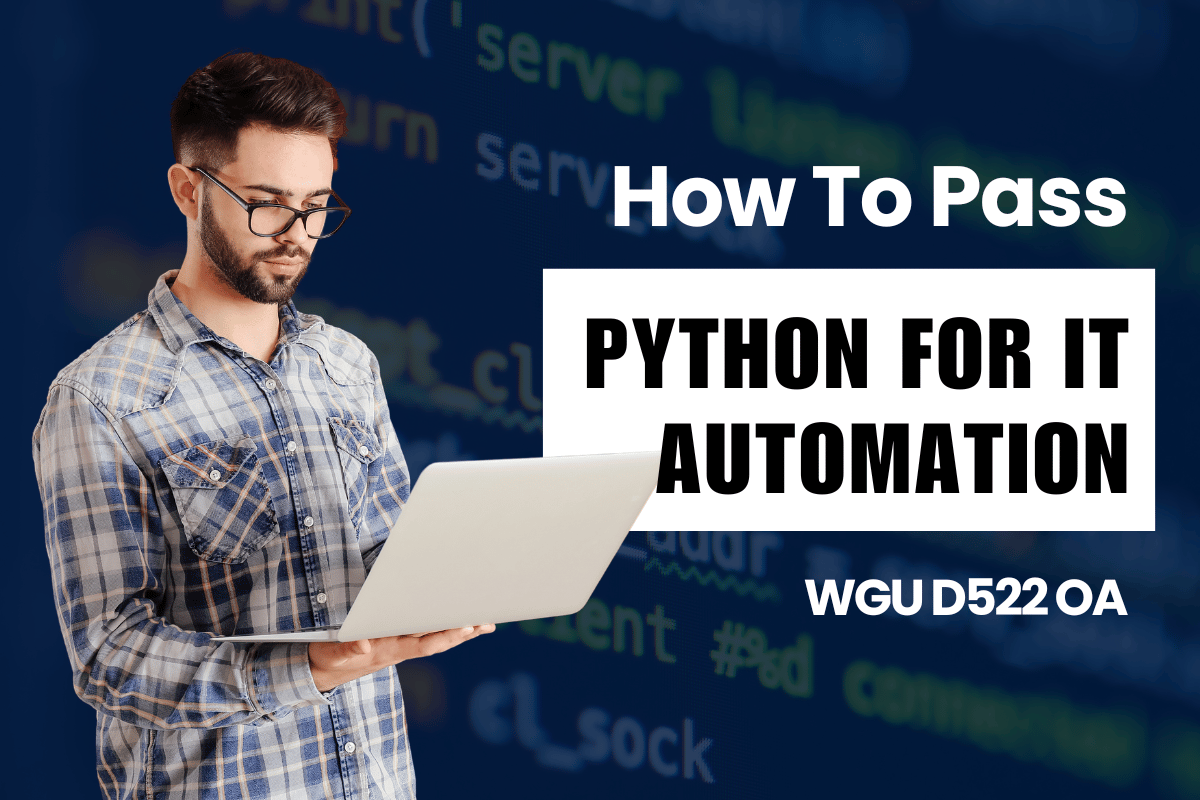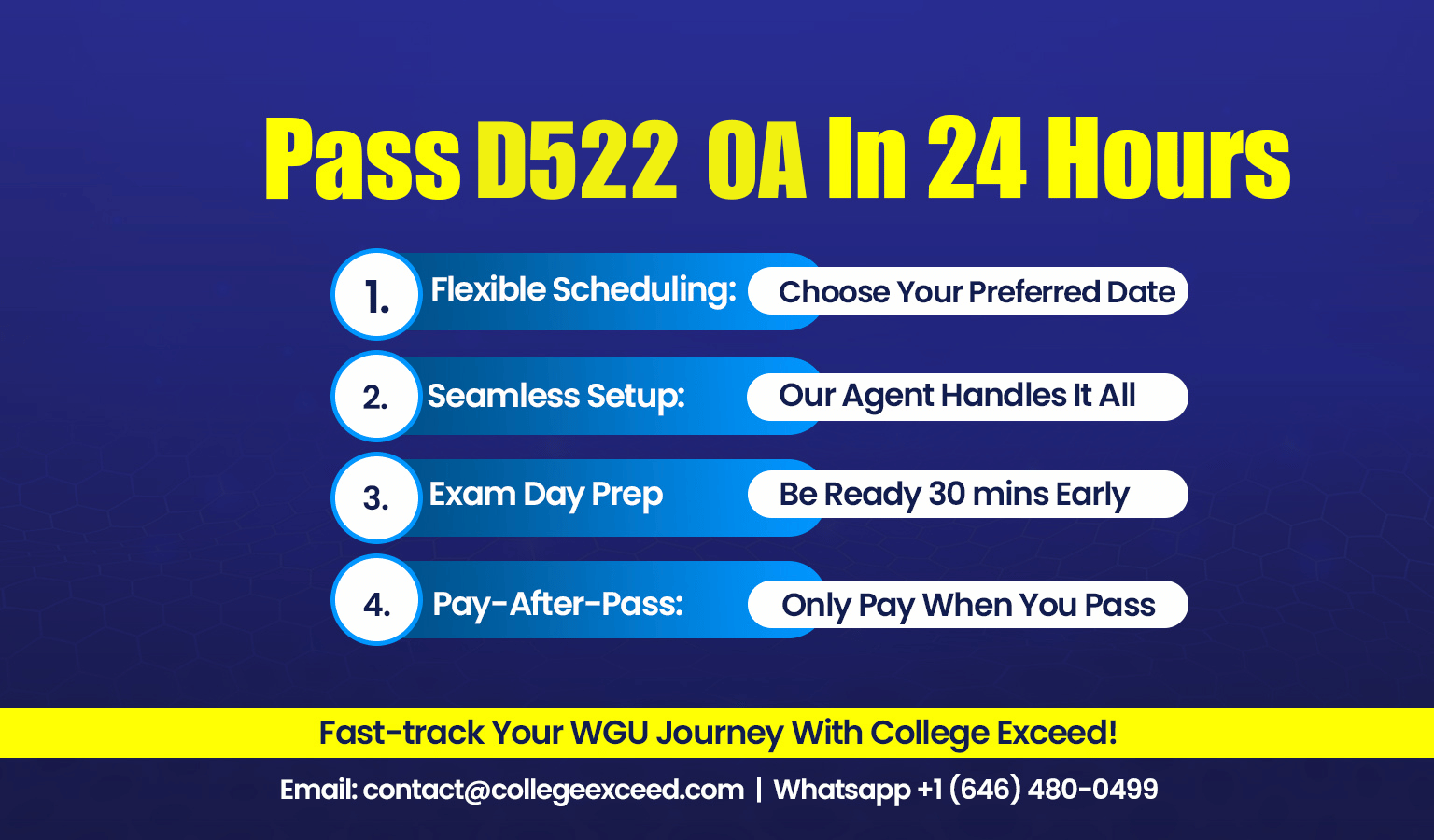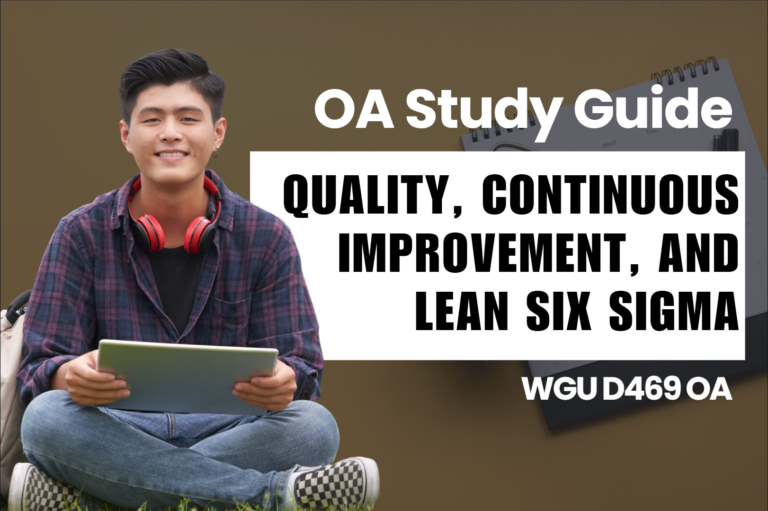Welcome to your go-to guide for acing the “Python for IT Automation WGU D522 ” course at WGU! No matter whether you have just begun with the module or you are almost through, this article is aimed at helping you find your way to success. Python is widely used in the IT industry and this course will enable you to carry out tasks, and processes and save time on your work.
In this article, you will find out all you need to know about the module: what it is, what is expected of you as a student; a guide to the week-by-week OA preparation; and a few links to other sources that can be useful for learning. We will also set some points of emphasis and address some of the questions you may have in this process referred to as FAQs. At the end of this guide, you will be fully prepared to face all the challenges arising from this course. Okay, let’s start the course off and learn how to master Python for IT Automation.
...
What You Need to Know About WGU D522 Python for IT Automation📖
This is your starting point for Python mastery for IT Automation and is covered in the “Python for IT Automation D522” course. This course is intended to give a profound understanding of Python with the set of important elements for the automation of tasks, data management, and optimization of IT processes. At the end of the course, you will be able to write Python scripts to carry out activities such as automation of specific tasks, file manipulation, and control of program flow to make decisions based on the data being manipulated.
This module is divided into units to take you through the Python language, its features, and what you can do with the language unit by unit starting with an introduction to Python. You will then move to meet variables, data types, and operators which are foundational components in any computer program in Python. As you advance, you get to know lists, tuples, dictionaries, and sets that are used in the handling of numerous data.
In this course, an emphasis is made on the use of programming logic and systematic as a tool to solve problems. The functions, If/Else statements, and loop are the chapters in Tutorial which will explain how one can segregate the code to repeat some operations and how the code can decide the operations when done dynamically. These are essential because they are a foundation for automating various IT processes and enhancing the performance of your scripts.
Further on, you’ll find how to check scripts for errors, and how to manage files, modules, libraries, and packages, all of which are tools that will make your Python programs better and help you do more work with less effort. The final part of the course is devoted to real-life applications of the gained Python skills to guarantee that you’ll be able to use the knowledge in practice.
As a result, this is not only a course written in code; it is a course in programming thinking and the approach to problem-solving. The pre-assessment and objective assessment will be quizzes, which will check your knowledge of these concepts with a focus on your ability to script with Python. Particularly, pay a lot of attention to chapters such as Loops and Logic, File Management Tasks, and Monitoring Scripts for Errors as these are some of the areas that are frequently used and therefore vital for the success of the course.
Creating a Study Guide for WGU D522 Python for IT Automation📝
A well-structured study plan is crucial to acing the Python for IT Automation D522 course. Here’s a week-by-week guide to help you stay on track and fully prepare for the Objective Assessment (OA).
Week 1: Download the Study Guide and Get Familiar with the Module Start by downloading the official study guide provided by WGU. This guide is your roadmap to understanding the course’s structure, key concepts, and the topics that will be heavily tested in the OA. Spend this week familiarizing yourself with the module’s overview and identifying which areas require more focus. Make notes on which chapters or concepts seem more challenging, so you can allocate extra time to them in the upcoming weeks.
Location: Course Search > D522 Study Guide
Week 2: Dive into the Textbook and Complete Lab Exercises In this second week, students will become engrossed with Python. Start on chapter one of the textbook and take a keen interest in the chapters dealing with variables, data types, operators, and functions. These are principal concepts that you need to learn. When reading through the textbook ensure that you do all the laboratory exercises highlighted in the following instructions. These exercises will also allow you to put theory into practice and gain that all-important consolidation. Do not omit it even if you do not like quizzes, for they help strengthen your knowledge and help you pass the sorts of questions that you meet in the OA.
Week 3: Watch Recorded Videos and Participate in Cohorts Now that you have understood what Capture is all about, the following is the suggested plan for the week regarding the recorded videos and cohorts. Attend the recorded videos presented in the course and, if possible, engage in any possible live cohort sessions. In most cases, such videos give a better understanding of the given subject, in addition to helping to explain issues that may not be found in the text. While you watch, also take as many notes as possible and do not shy off going over the areas that were a little hard. If possible do ask questions in the cohort sessions since this is where questions can be asked to full clarity.
Location: Course Search > D522 Videos & Recorded Live Sessions
Week 4: Attempt the Pre-Assessment (Pre-A) By now you should have garnered some basic skills and practical skills on which you can polish yourself. The Pre-Assessment (Pre-A) should be completed this week. The target is to get at least 85% in your exam before proceeding to the OA. The Pre-A is there to mimic up the OA so just approach the Pre-A as practice. In case you are not able to score your intended target in the first instance, do not despair – take the Pre-A as many times as you want until you get it right.
Week 5: Prepare for and Take the Objective Assessment (OA) This is the week you’ve been working towards. By now, you should feel confident in your understanding of Python and its application in IT automation. Review your notes, rewatch any videos on topics you found challenging, and take a final look at the study guide. When you’re ready, schedule and take the Objective Assessment (OA). Remember to stay calm and apply the problem-solving strategies you’ve practiced. Good luck!
...
Top Tools and Resources for Python for IT Automation👨🏻🏫
Here are some free online resources to supplement your learning and give you extra practice:
Extra Coding Practice: CodingBat
- Link: CodingBat Python Exercises
- Description: Practice interactive Python exercises to build your coding skills.
Comprehensive Python Tutorials: W3Schools
- Link: W3Schools Python Tutorial
- Description: Learn Python basics and beyond with easy-to-follow tutorials.
Intro to Python Fundamentals: Khan Academy
- Link: Khan Academy Python Fundamentals
- Description: Get a solid introduction to Python with interactive lessons.
Python for Beginners: Udemy
- Link: Python for Beginners on Udemy
- Description: A structured course with video lectures covering Python essentials.
Python Bootcamp: Bro Code on YouTube
- Link: Python Bootcamp by Bro Code
- Description: A comprehensive video series that covers Python from the ground up.
These resources are great for additional practice and a deeper understanding of Python.
...
D522 OA Success Tips for Python for IT Automation 👨🏻🏫
Preparing for the Objective Assessment (OA) in the Python for IT Automation D522 course requires a strategic approach. Here are some key topics and tips to help you succeed:
Use of External Resources
- Watching YouTube tutorials and using tools like ChatGPT can significantly enhance your understanding. When using ChatGPT, ask it to solve problems as a beginner would, making the explanations more relatable to your level of understanding. This approach can clarify complex concepts and help you break down the code into manageable parts.
Practice with Pre-Assessment (PA) Questions
- The pre-assessment questions are very similar to those you’ll encounter in the actual OA. Practice them thoroughly, aiming to understand not just the correct answers, but the reasoning behind them. This will build your confidence and prepare you for the types of questions you’ll face.
Key Concepts to Master
- Ensure you’re comfortable with Python data structures such as sets, lists, tuples, and dictionaries. Know how to create and use custom functions, and be familiar with built-in functions like len(), range(), max(), islower(), and isupper().
- Operators, index positions, and the use of modules and libraries are crucial. Review these topics extensively, as they form the backbone of many exam questions.
- String manipulation is another important area. Practice joining, splitting, and checking string properties (e.g., upper, lower, numeric). Understand how to add or remove items from lists, tuples, and sets, and be familiar with keywords like “in” and “if” conditionals.
Exam Tips
- The OA will include multiple-choice and coding questions, with a significant portion requiring you to write code from scratch. Be prepared to use the help() function during the exam, as it can assist with any uncertainties regarding Python syntax or functions.
- For coding questions, pay close attention to the comments in the code. Often, the comments will contain crucial hints or instructions like “don’t erase this line,” which can guide you toward the correct solution.
- Remember that the Python interpreter is available during the exam. If you’re unsure about a particular question, use the interpreter to test your ideas before submitting your answer.
- Most importantly, if a question seems complex, read it again carefully. The exam questions are designed to be straightforward, so if you’re finding one difficult, it’s likely that you’re overlooking a key detail.
Coding Questions
- Expect around nine coding questions in the exam, with the remainder being multiple-choice. Focus on practicing how to write clean and efficient code, as you’ll need to demonstrate your ability to apply Python concepts in real-world scenarios.
By concentrating on these key topics and following these tips, you’ll be well-prepared for the OA. Remember, practice is key—make sure to spend time coding, reviewing the material, and taking full advantage of the resources available to you.
...
FAQs for D522 Python for IT Automation❓
Q: How difficult is the Python for IT Automation D522 course?
- A: The challenge level of this course depends on your experience of programming to tell the level of ease or the level of difficulty. It is evident that if you are a beginner in Python or programming at large, some topics are quite demanding. However, the course does not dictate that you start off by knowing all the answers; in fact, it provides you with lots of support. If you write regularly and use other external resources like YouTube or ChatGPT, the difference can be rather noticeable.
Q: What should I focus on to pass the OA?
- A: Concentrate on practicing data in Python, additional and built-in functions, and string operations, lists, sets, tuples, and dictionaries. Program daily and ensure you are confident with the concepts being taught in the class, for instance, loops, conditional statements, and modules. The pre-assessment is a good measure of your preparedness so ensure you get more than 85% before touching the OA.
Q: How similar is the pre-assessment to the actual OA?
- A: The questions in the pre-assessment are very close to the questions in the actual OA in both the content area and the type of questions that are asked. Using it is a perfect way of checking how well one understands the material and which sections require further study. The pre-assessment should be given as much consideration as the actual OA since it serves as a last evaluation before one secures an OA.
Q: What types of questions are on the OA?
- A: The OA consists of multiple-choice and coding questions, with a significant focus on writing Python code from scratch. Expect around nine coding questions, which will test your ability to apply Python concepts in practical scenarios. The remaining questions are multiple-choice, which will test your understanding of key concepts and your ability to think critically.
Q: Can I use any resources during the OA?
- A: Yes, you have access to a Python interpreter during the OA, which can be extremely helpful. If you’re unsure about a particular syntax or function, you can use the interpreter to test your ideas before finalizing your answer. However, remember to rely on your knowledge and practice, as time management is crucial during the exam.
...
Conclusion: Automating IT with Python📄
The Python for IT Automation D522 course can be considered a building block in the process of establishing proficiency in Python and using it for automating IT processes. Altogether, I consider the course to be quite workable, although I had some troubles during work on it as a complete beginner in the programming field However, as in any course, constant practice and application of all available resources will enable me to go through the course successfully. Make sure to stay on topic and use all the key concepts such as data structures, functions, and string manipulation and it would be useful to treat the pre-assessment as a mixed practice where you can practice all of the aspects of the OA.
Remember, the more you practice, the more confident you’ll become. Take advantage of online tutorials, coding exercises, and the Python interpreter during the exam to reinforce your understanding. With determination and the right approach, you’ll not only pass the OA but also gain skills that will be invaluable in your IT career.
Stay focused, keep coding, and you’ll achieve success in this course!






